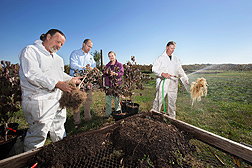State Department’s Gift of Dogwoods to Japan
in Honor of 100th Anniversary of Cherry Tree Gift
More than 100 years ago, the Japanese government presented flowering cherry trees as a gift to the U.S. government. Those wonderful living gifts have blossomed along the National Mall’s Tidal Basin, as well as at other locations around Washington, D.C., since then.
In April 2012, Secretary of State Hillary Clinton announced a gift of 3,000 flowering dogwood trees to Japan to commemorate the 100th anniversary of Japan’s gift of cherry trees to the United States.
The job of finding the right dogwoods belongs to scientists at the U.S. National Arboretum, in Washington, D.C. Agricultural Research Service plant geneticist Richard Olsen has worked to determine the appropriate dogwood cultivars for the varied Japanese climate and to locate the planting material.
“There are many things to consider, including temperature range and insect pests to which particular dogwood candidates may be susceptible,” says Olsen.
The planning group—which includes the U.S. Department of State; the U.S. Department of Agriculture’s Animal and Plant Health Inspection Service, Forest Service, and ARS; and the U.S./Japan Bridging Foundation, a nonprofit organization—sent the first batch of 150 trees to Japan, and they were planted in Tokyo in November 2012. Altogether, a total of 1,000 will be planted in Tokyo, 1,000 in the Tohoku region in honor of the tsunami victims, and the final 1,000 will be distributed to schools and other organizations throughout the country.
“We are evaluating the performance of dogwood germplasm at the arboretum as well as novel cultivars available in the American nursery industry to find those most suited to the Japanese clime,” says Olsen. The arboretum has, for decades, collected dogwood germplasm from across the United States—it is found from Florida to Michigan and as far west as Missouri and Texas.
The arboretum’s Woody Landscape Plant Germplasm Repository holds many species of dogwood as well as other trees and shrubs. The repository serves to introduce, maintain, and distribute diverse and wild-origin genetic resources of trees and shrubs for landscape use through collection, exchange, and evaluation. Woody plant germplasm is also evaluated for production potential and further characterized using molecular technologies.
The repository is responsible for maintaining more than 200 woody plant genera. More than 1,400 accessions of seeds are maintained in storage for direct distribution, and another 2,800 living plants are maintained on site at Beltsville and Glenn Dale, Maryland; and in Washington, D.C.—By Sharon Durham, Agricultural Research Service Information Staff.
This research is part of Plant Genetic Resources, Genomics, and Genetic Improvement, an ARS national program (#301) described at www.nps.ars.usda.gov.
Richard Olsen is in the USDA-ARS Floral and Nursery Plants Research Unit, U.S. National Arboretum, 3501 New York Ave., N.E., Washington, D.C. 20002; (301) 504-5657.
"State Department’s Gift of Dogwoods to Japan in Honor of 100th Anniversary of Cherry Tree Gift" was published in the February 2013 issue of Agricultural Research magazine.







